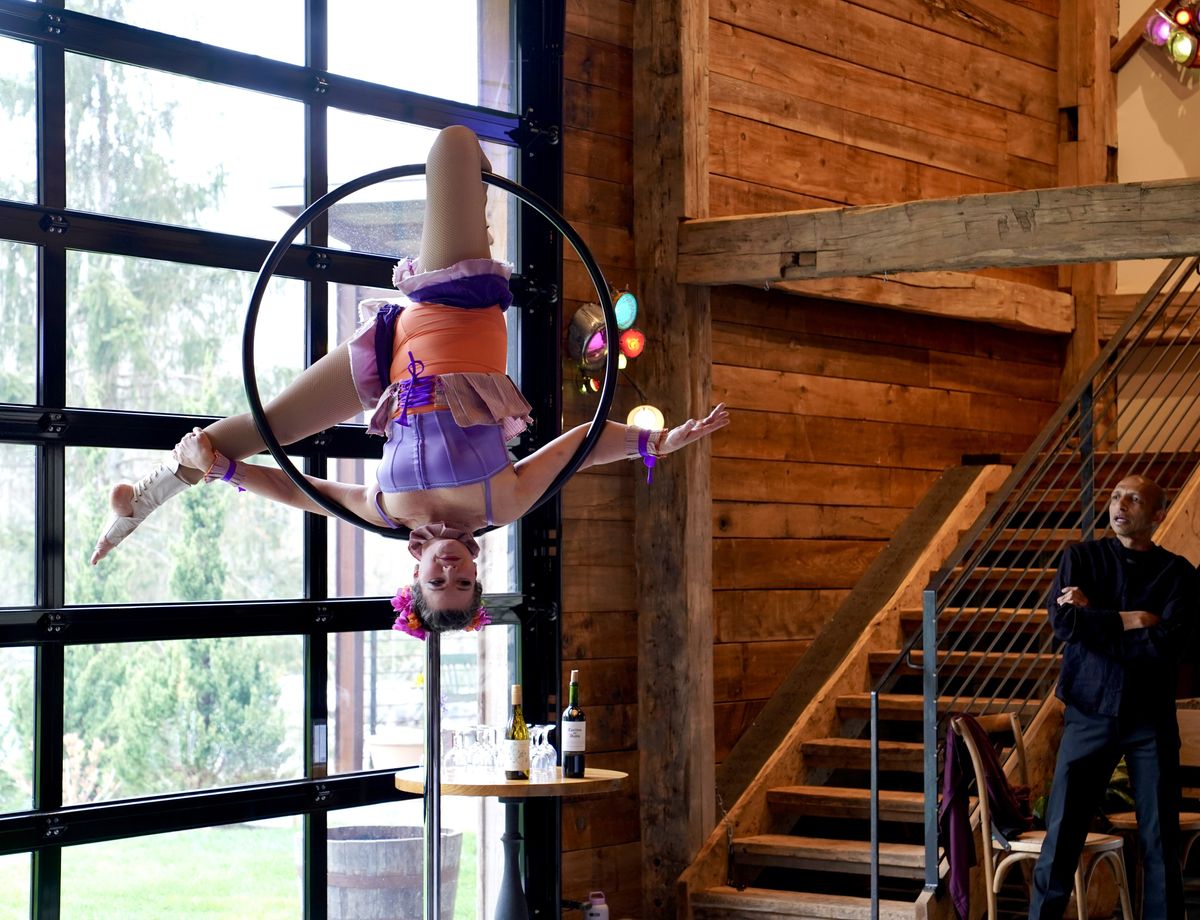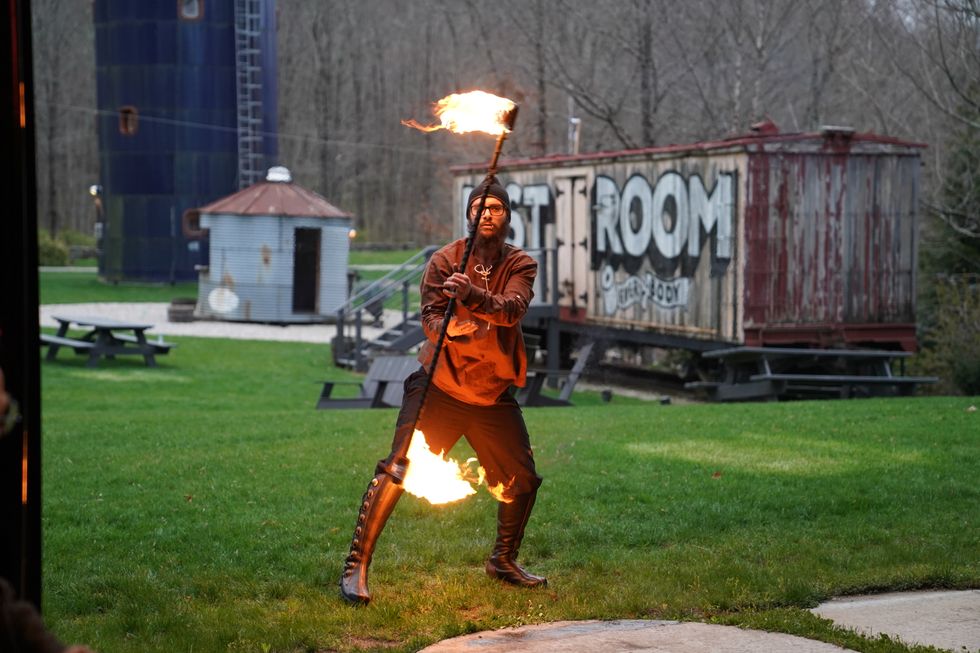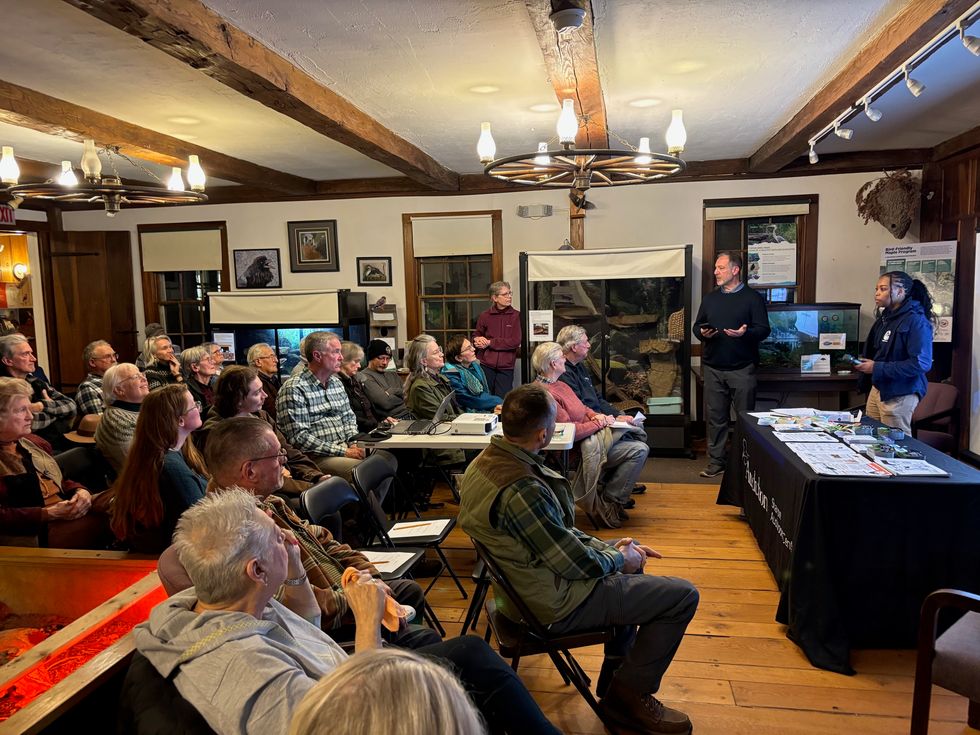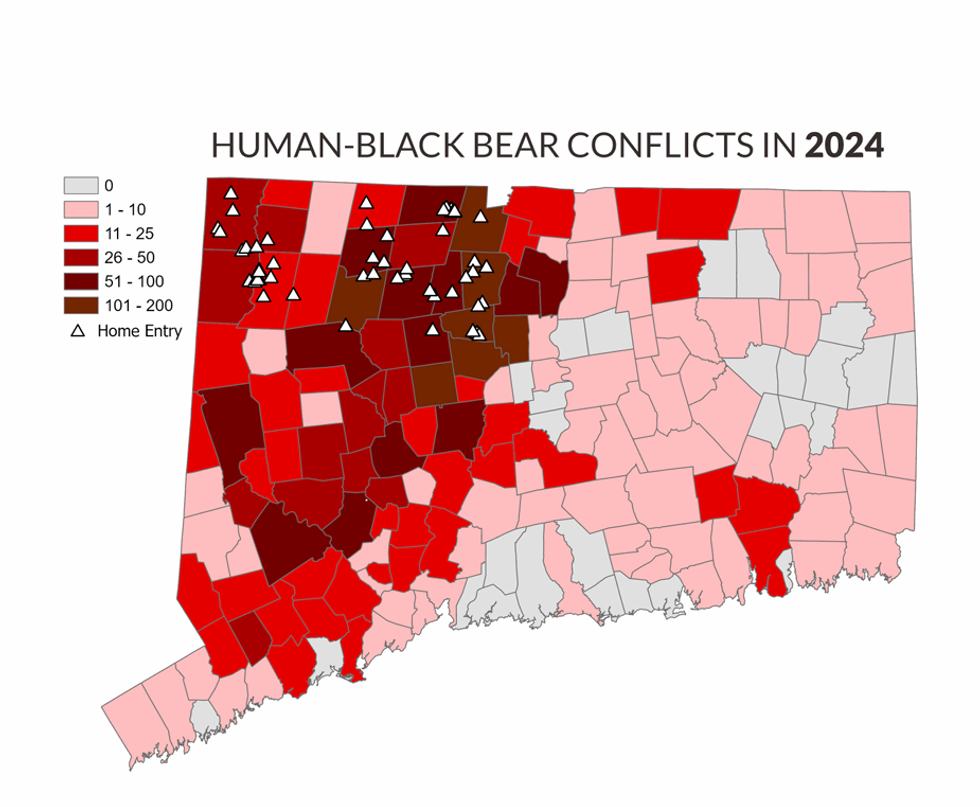NWCT Arts Council: Arts Connected

Matica Circus duo from Harwinton, Connecticut performing at NWCT ARTS Connected event in May
Jennifer Almquist

Matica Circus duo from Harwinton, Connecticut performing at NWCT ARTS Connected event in May
The Northwest Connecticut Arts Council (NWCT Arts) recently held Arts Connected, their first fundraiser, at the Spring Hill Vineyard in Washington, Connecticut. The evening celebration, a combination of Fellini movie, carnival, and Renaissance Fair, featured an aerialist from Matica Circus in Harwinton, and a flame and flow performer out in the courtyard under the stars. Momix, based in Washington Connecticut, under the artistic direction of founders Moses Pendleton and Cynthia Quinn, also performed. Two dancers wore Jeff Koons-style inflated red dog suits, and Momix dancer Jared Bogart wafted through the space wearing an immense, two-stories tall silk fan. Persian calligraphic painter Alibaba Awrang created a community work of art, while Ameen Mokdad, a violinist from Iraq, made music with Hartford’s Cuatro Puntos Ensemble. A young musician, Adelaide Punkin, performed an original song from the balcony of the vast space, while a giant puppet from Sova Dance and Puppet waltzed through the festivities. DJ Arvolyn Hill from Kent spun the tunes, an African drum circle set the rhythm, and there was abundant food and drink for the gathered crowd.
NWCT Arts is one of 8 regional Arts Councils designated by the Connecticut Office of the Arts, a branch of the Department of Economic and Community Development (DECD). The mission of NWCT Arts is to “elevate the role of the arts to build community and economic vitality.” The NWCT Arts was founded by Amy Wynn in June of 2003 in collaboration with the Northwest Connecticut Community Foundation and the Northwest Connecticut Chamber of Commerce.
Brian Boye, Litchfield County resident, Vice President at Nike Communications, NWCT Arts board member emphasized “Our goal with Arts Connected was to highlight the rich tapestry of artists that live and work in our community. We are blessed with such a diverse range of talent, from world-class dance ensembles like Momix to incredible visual artists like Stace Dillard who work solo in studios across our 25 towns. I am thrilled that we were able to feature more than 80 local artists in a variety of formats throughout the event. Our art gallery featured more than 60 artists and we had live performances from musicians, calligraphers, DJs, drummers, photographers, dancers, aerialists, and singers. It was such a joy to witness the community coming together to celebrate all this talent.”
Steph Burr began her time as Executive Director of NWCT Arts in the heart of the Covid pandemic. A fierce advocate for artists, Burr had to immediately shift gears to create the NWCT Artist Emergency Relief Fund to aid local creatives through the hardship caused by COVID-19. NWCT Arts raised funds to support artists in financial distress. 51 artists from 13 towns in the region applied for help; arts educators, performing artists, musicians, commercial artists, fine artists, and artisans who depend on craft fairs and farmer’s markets to sell their wares. 73% of the applicants were not receiving unemployment and 31% of those applying were housing insecure. Burr is also an artist who lives in Torrington.
For 20 years, the Arts Council has been advocating for artists and the creative process in our region. They empower, facilitate, network, collaborate, and secure funding for local arts initiatives. Burr knows it is still hard for new arts organizations, and artists, to achieve lift-off. Funding for the arts has been cut back by the State to pre-pandemic levels with no adjustment for inflation. Burr would like to see greater advocacy from more established artists and organizations to help emerging artists get on their feet.
Board member Boye said, “We want to raise the profile of the Northwest Connecticut Arts Council, which typically works behind the scenes to ensure that artists and arts organizations can continue to thrive in our 25 towns. We’ve learned over the past few years that the arts are a major economic driver here. When we have a thriving arts community, people will visit our towns, shop in our stores, eat in our restaurants and stay in our inns. In 2022, the non-profit arts and culture industry generated more than $30 million in economic activity in our community. But there are a lot of challenges artists face to live and work here. Our mission is to ensure that there’s a network of support for them. We know that access to their work brings joy to us individually, but it also positions our region as a cultural destination that has a positive economic effect that benefits everyone.”
NWCT serves the towns of Barkhamsted, Bethlehem, Burlington, Colebrook, Cornwall, Falls Village/Canaan, Goshen, Hartland, Harwinton, Kent, Litchfield, Morris, New Hartford, New Milford, Norfolk, North Canaan, Plymouth, Roxbury, Salisbury/Lakeville, Sharon, Thomaston, Torrington, Warren, Washington, and Winchester/Winsted.
Sunday Fisher, chair of the board of directors, lives in Sherman and is an operational strategist after decades working in the retail world. “Northwest Connecticut is truly a special place, renowned as a sanctuary where artists have historically come to create and find inspiration. It’s my hope that our region be recognized as a vibrant hub for all forms of art. At the Council, we are deeply committed to honoring our rich history as stewards of this artistic legacy while also forging paths that ensure the arts not only survive but thrive. Balancing these roles is essential to fostering an environment where the arts can flourish and enrich our community for generations to come.”
“The arts are a powerful economic engine for our region and are very worthy of expanded investment,” said Burr. “Our nonprofit arts organizations connect our communities and help define our culture. They also attract substantial revenue to the local economy and support many jobs and small businesses. It is no easy feat to do both.” NWCT Arts is working closely with the Connecticut Department of Tourism as the arts are responsible for increased tourism in the region.
Our state representative Maria Horn agrees with Burr. “Arts and culture are a defining part of the Northwest Corner for those who live here and those who visit the region. Communities like ours that support arts and culture not only enhance their quality of life— they also invest in their economic well-being. We know this because we’ve studied it.”

Stephen Gass, former President of sesamestreet.org, and vice board chair said, “When I was asked to join the board of the NWCT Arts Council, I said “OK” with one condition: the organization embraces the idea that our area’s sustainability does not rely solely on caring for our environment. Rather, given the countless ways the arts can feed our collective souls, fuel curiosity, create shared experiences, and critically serve as economic drivers, we champion the idea that the arts are essential to our well-being. Just as environmental sustainability requires that we think beyond a town’s borders, the NWCT Arts Council’s 25-town purview provides the “big picture” perspective that helps ensure a rich, far-reaching, and fertile arts and culture landscape for us all.”
Executive Director Burr, whose dream for NWCT Arts is to provide equity in the arts, reiterated their underlying credo, “As an arts organization, we work to put the voices that are most unheard at the forefront to empower the movement toward creative justice. The arts are a human right and bring us together to celebrate cultural diversity. Everyone deserves access to art and culture, to be included, and to feel a sense of belonging. We are dedicated to serving the needs of everyone regardless of race, age, physical or mental ability, religion, gender, sexual orientation, or economic status.”
NWCT Arts recognizes the positive impact the arts have on our mental health. Access to arts and culture is a universal human right, meeting both a social and psychological need. Jackie Armstrong, an educator at MOMA, said “Art can harness the healing power within each of us and help bring us into community with one another. When in front of an artwork, we are connected to the artist and to others who have experienced it. And connection, to us and others, is at the core of art and healing.”
Board chair Fisher continued, “As we reflect on the success of our first annual fundraiser, we’re filled with optimism about the future of the arts in Northwest Connecticut. This event has crucially boosted our ability to provide artists with the everyday tools they need to flourish. Our aim is to elevate the arts across the towns we serve, emphasizing not only their role in fostering community connections but also their significant impact as an economic driver. Looking ahead, we envision a partnership where municipalities seamlessly invest in arts and culture, ensuring every resident has access to these enriching experiences. Our first annual event marks a pivotal step towards making that dream a reality.”
Burr summed it up, “Our plan is grounded in the belief that the arts have the power to transform lives and communities and that by supporting artists and the creative process, we can create a more vibrant and prosperous region. I am so grateful for the support of our board, staff, and stakeholders. I am confident that together we can achieve our vision of a region where artists can thrive, and everyone can experience the arts.”
How can people help the NWCT Arts Council? They currently have eighty paid members. Information on how to join or support them and listings of future arts events can be found by going to www.artsnwct.org
Mohawk Mountain was making snow the first week of December. The slopes host practices and meets for the HVRHS ski team.
FALLS VILLAGE — After concluding a successful autumn of athletics, Housatonic Valley Regional High School is set to field teams in five sports this winter.
Basketball
Berkshire League basketball tips off Tuesday, Dec. 14. HVRHS’s girls' and boys' squads will face Nonnewaug High School to start the season. The boys' varsity team is under new leadership this year with the addition of head coach Bobby Chatfield. The boys will be out for revenge in the season opener at Nonnewaug, which knocked HVRHS out of the BL postseason tournament last year.
The girls will be at home Dec. 14 for the first league game of the basketball season. Coach Jake Plitt returns for his fourth season at the helm. Last year, the HVRHS girls were eliminated in the semifinals of the BL tournament by Northwestern Regional High School on their way to repeating as champions.
Hockey
Ice hockey players have joined a co-op team this year with New Milford High School. Two HVRHS athletes will be on the team: Logan Miller and Melanie Rundall.
Games and practices will be held at Canterbury School’s O’Neil Arena. The first official hockey game of the 2025-26 season will be Dec. 17 at home against the Newtown-New Fairfield co-op.
The Housatonic co-op team that was previously led by coach Dean Diamond disbanded after last season due to a player shortage. The New Milford co-op is led by coach Hank Dietter.
Swimming
The HVRHS swim team will begin the season with a road stretch. The first meet will be held Dec. 18 at Shepaug Valley High School, followed by meets at Northwestern and then Lakeview High School. The first home meet for the swim team will be Jan. 14 against Nonnewaug, held at The Hotchkiss School’s pool.
New to the team this year is freshman Phoebe Conklin, who competed at the YMCA National Long Course Swimming Championships in Ocala, Florida, this past summer. Conklin qualified for nationals in the 50-meter freestyle, 100-meter freestyle and 100-meter butterfly. The HVRHS swim team is coached by Jaqueline Rice.
Skiing
The HVRHS ski team practices and competes at Mohawk Mountain ski area in Cornwall. Competition will hit the slopes beginning with a group meet at home Wednesday, Jan. 14.The HVRHS ski team is coached by Bill Gold.
Indoor track
The last winter sport to get underway will be indoor track. Silas Tripp was the lone Mountaineer to sign up for the sport. He will represent HVRHS in meets, but travel with Lakeview athletes to meets. The first scheduled event will be at Bethel the weekend of Feb. 6 to Feb. 8.
A mother bear and her cubs move through a backyard in northwest Connecticut, where residents told DEEP that bear litters are now appearing more frequently.
SHARON — About 40 people filled the Sharon Audubon Center on Wednesday, Dec. 3, to discuss black bears — and most attendees made clear that they welcome the animals’ presence. Even as they traded practical advice on how to keep bears out of garages, porches and trash cans, residents repeatedly emphasized that they want the bears to stay and that the real problem lies with people, not wildlife.
The Connecticut Department of Energy and Environmental Protection (DEEP) convened the meeting as the first in a series of regional Bear Management Listening Sessions, held at a time when Connecticut is increasingly divided over whether the state should authorize a limited bear hunt. Anticipating the potential for heated exchanges, DEEP opened the evening with strict ground rules designed to prevent confrontations: speakers were limited to three minutes, directed to address only the panel of DEEP officials, and warned that interruptions or personal attacks would not be tolerated.
“We really want to hear from you,” said Justin Davis, DEEP’s bureau chief for natural resources, at the meeting. He said that DEEP is preparing a bear management report in early 2026 that evaluates the challenges the state is facing and the strategies going forward dealing with them. He said the report will include feedback from the public generated at the listening sessions. He urged attendees, however, not to turn the meeting into a discussion about whether there should be a hunt or not.
Davis called the return of black bears to Connecticut a “conservation success story,” but one that now comes with challenges. "They're large animals, they're powerful and they can become comfortable being around people--and they're opportunistic, and they love to eat."
DEEP shared data showing that black bears have been reported in nearly every Connecticut town and that conflicts involving trash, bird feeders, livestock and home entries have increased sharply in recent years. The state’s bear population was last estimated at roughly 1,100 to 1,200 animals, a number that DEEP recognizes has grown since the study was conducted in 2012.
Eric Hammering, the office director of Environmental Review & Strategic Initiatives at DEEP, told the attendees that since 2020 there have been 264 reported home entries in 38 municipalities in northwest Connecticut, citing data from the state's State of the Bears report released in March.
A home entry, he said, is defined as an event when a bear actually goes inside a resident's living space.

DEEP officials stressed that bird feeders and unsecured household trash are the two biggest drivers of bear conflicts. They advise residents to remove feeders entirely and keep their garbage inside or in bear-resistant containers. DEEP representatives noted that once a bear discovers food, it is likely to develop habits and return.
Many attendees said they see widespread noncompliance in their neighborhoods — particularly among part-time residents and short-term rental guests who leave trash out for days. Several said they were frustrated that the people causing the problem are often not the ones who attend sessions like this.
As a result, a number of residents called for stronger statewide enforcement, including fines for leaving trash unsecured and penalties for repeated violations. Without consequences, they said, the same households will continue to attract bears and put neighbors at risk. Others described practical steps to reduce bear activity--including the use of secure dumpsters, food composting stations, and the placement of electric fencing around livestock and beehives.
Again and again, residents emphasized that the underlying issue is human behavior. One attendee summarized it succinctly: “There are 3.6 million people in Connecticut and far fewer bears. Human behavior is the problem.”
Lynn Levine, a Litchfield resident who enjoys seeing bears, said common sense steps are the answer. She said that when she first moved to the area, she mistakenly left her garage down open with a 15-pound bag of shelled peanuts inside. "A bear dragged the bag around the side of the garage, sat down and had a teddy bear picnic." She said she learned not to leave the garage door open, especially with food inside.
Not all the stories were lighthearted. An 82-year-old Sharon woman recounted repeated break-ins that left her shaken and facing thousands of dollars in repairs, including a bear walking into her kitchen while she was washing dishes. A veterinarian described livestock attacks, including an alpaca that was mauled and dragged. A farmer said bears caused about $160,000 in crop losses in one year and that cornfields across the region face similar damage.
Several speakers added that DEEP’s limited staffing means local police often end up responding when bears are struck by cars or behaving aggressively.

Cornwall First Selectman Gordon Ridgway, who attended the session, said afterward that he was troubled by how outdated the state’s population data is.
“My biggest personal take-away was surprise — that DEEP doesn’t have a handle on how many bears are here,” he said. “They said they haven’t surveyed them since 2012. How do you make a plan or policy without doing a survey?”
Ridgway said Cornwall has received about 40 bear-related reports this year, including home and vehicle entries and injuries to pets. “People are frightened by intrusions onto their property,” he said. “These are not happy stories.”
He noted that in 2012 -- when the state said it last did its population count -- “a bear was a novelty,” but sightings today are very common. “Today, most people see a bear every week. It’s no longer a novelty — it’s a real issue.”
Ridgway said he supports developing a statewide management plan and wants Connecticut to examine approaches used in other states, including reducing their numbers.
While most attendees at the Dec. 3 session indicated they opposed a hunt, Ridgway said that is not a true reflection of how his constituents in Cornwall view the issue. “If we had a vote, it would be close as to whether there should be a hunting season.”
Only one attendee — a longtime hunter from West Cornwall — advocated for a controlled bear hunt. He argued that the population is “exploding” and that education and bear-proof containers are “a band-aid.” In keeping with DEEP’s rules, other residents did not respond, and the session took place without conflict.
Much of the remaining discussion centered on unsecured trash, short-term rentals, and outdated dumpsters at state parks that residents say train bears to expect human food. Some questioned why the listening session was not better publicized, and Ridgway echoed that concern, saying it should have also been held at the high school to allow more residents to attend.
DEEP collected comment cards at the end of the session. Staff said all feedback will be reviewed as the agency drafts its statewide bear management report.
Rick Osborne, manager of the Kent Transfer Station, deposits the first bag of food scraps into a new organics “smart bin.” HRRA Executive Director Jennifer Heaton-Jones stands at right, with Transfer Station staff member Rob Hayes at left.
KENT — Residents now have access to around-the-clock food-scrap composting thanks to two newly installed organics “smart bins,” unveiled during a ribbon-cutting ceremony Monday morning, Dec. 1.
Rick Osborne, manager of the Kent Transfer Station, placed the first bag of food scraps into the smart bin located at 3 Railroad St. A second bin has been installed outside the Transfer Station gate, allowing 24/7 public access even when the facility is closed.
The initiative is part of a regional effort to expand composting opportunities and reduce the amount of waste sent to state trash facilities. Housatonic Resources Recovery Authority Executive Director Jennifer Heaton-Jones, who attended the ceremony, said the bins demonstrate what small towns can achieve in addressing Connecticut’s broader waste challenges.
“This is proof that even our smallest towns can make a big difference in tackling the waste crisis in our state,” Heaton-Jones said.
Also present at the event was Transfer Station staff member Rob Hayes.
Cornwall First Selectman Gordon Ridgway
CORNWALL — Housing and healthcare topped the list of 15 goals the Board of Selectmen set for the next two years, reflecting the board’s view that both areas warrant continued attention.
First Selectman Gordon Ridgway and Selectmen Rocco Botto and John Brown outlined their priorities during the board’s regular meeting on Tuesday, Dec. 2. On housing, the board discussed supporting organizations working to create affordable options in town, and Botto said the town should also pursue additional land acquisitions for future housing.
On healthcare, Ridgway underscored the importance of mental health services, social services and the town’s Food & Fuel Fund. The selectmen also noted shifts in the regional healthcare landscape, including the opening of the Community Health & Wellness Center in North Canaan and Northwell Health’s new ownership of Sharon Hospital.
Other goals included continuing to work on the West Cornwall wastewater plant, improving the Transfer Station, renovating town buildings, enhancing cell service, working on the Plan of Conservation and Development, supporting volunteer organizations in town, attracting new residents and businesses, creating more recreational resources, public transportation, celebrating America’s 250th birthday and revitalizing the town’s business centers.
“There’s increasing needs for all these things,” said Ridgway.
Winter parking rules
The Dec. 2 meeting was held on Zoom due to snowy conditions in Cornwall. The selectmen said they plan to implement winter parking rules at their next meeting on Dec. 16.
Ridgway also reminded residents to keep vehicles at least 10 feet from the edge of the road so plows can safely clear streets during storms.